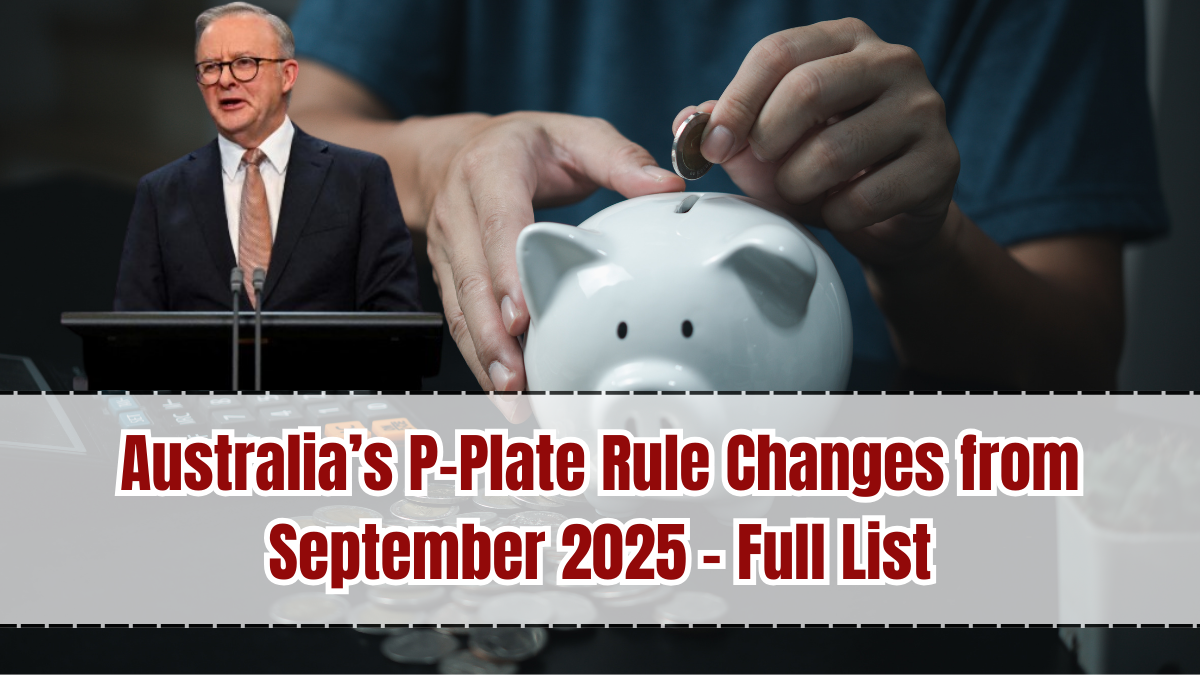Young drivers in Australia are set to face new road safety measures as the government implements a significant update to P-Plate Rules Australia. Beginning in September 2025, new restrictions will come into effect across multiple states and territories, aimed at reducing accidents involving provisional drivers. These new road restrictions 2025 focus on curbing high-risk behaviors, improving road discipline, and strengthening the training process for novice motorists.
For thousands of young Australians preparing to drive independently, these changes represent both challenges and opportunities to develop safer driving habits.

Why the New Rules Were Introduced
Australia has one of the highest rates of road fatalities among young drivers compared to other age groups. Provisional license holders, or “P-platers,” are statistically more likely to engage in risky driving behaviors such as speeding, mobile phone use, and late-night driving. The updated P-plate rules starting in September 2025 aim to:
-
Reduce accidents involving inexperienced drivers.
-
Encourage responsible driving habits early on.
-
Standardize rules across different states for better consistency.
-
Address new risks linked to distracted driving and high-powered vehicles.
By implementing these measures, the government hopes to cut road fatalities while ensuring safer journeys for all.
Key Rule Changes from September 2025
The P-Plate Rule Changes in Australia include a mix of new restrictions and tightened enforcement:
-
Passenger Restrictions:
P-platers will be limited to carrying one passenger under 21 years old between 10 PM and 5 AM. Exceptions will apply for family members. -
Phone Use Ban:
Even hands-free devices will be prohibited for provisional drivers. Only fully licensed drivers can use Bluetooth or voice-activated calling. -
Curfew Expansion:
Certain states will extend night-driving restrictions for P1 drivers, reducing risks during high-accident hours. -
Zero Alcohol and Drugs Policy:
A strict 0.00% BAC (Blood Alcohol Content) will be enforced, with harsher penalties for breaches. -
Vehicle Power Limits:
Restrictions on high-performance cars will be updated, banning provisional drivers from operating turbocharged, V8, or modified vehicles unless granted exemptions. -
Mandatory Safety Courses:
Before moving from P1 to P2 licenses, young drivers must complete an accredited defensive driving course.
These changes mark one of the most comprehensive overhauls of P-plate regulations in recent years.
How the New Restrictions Will Be Enforced
Enforcement will be carried out through both traditional policing and new technologies:
-
AI Speed Cameras: Monitoring speeding and mobile phone violations.
-
Increased Patrols: More police presence around nightlife districts and highways.
-
License Point Systems: Stricter penalties for rule breaches, with fewer points available for P-platers.
-
Vehicle Scans: Roadside checks to identify restricted high-powered vehicles.
Young drivers will need to adapt quickly, as breaches can lead to suspensions, extended license periods, or hefty fines.
Benefits of the Updated Rules
The P-Plate Rule Changes from September 2025 provide multiple benefits for road safety:
-
Fewer Accidents: Limiting risky driving behaviors reduces fatalities among youth.
-
Safer Roads: Other drivers and pedestrians benefit from improved safety compliance.
-
Better Training: Mandatory courses strengthen driving knowledge and preparedness.
-
Long-Term Habits: Encourages safer lifetime driving practices.
-
Insurance Advantages: Safer driving could lead to reduced insurance costs for young drivers over time.
By focusing on prevention, the government expects measurable reductions in accidents involving provisional license holders.
Public Concerns and Criticisms
While widely supported, the reforms have sparked debates:
-
Freedom Limitations: Some young drivers feel the restrictions, such as curfews and passenger limits, are too strict.
-
Regional Inequality: Rural drivers argue that long distances and limited public transport make rules harder to follow.
-
Cost Concerns: Mandatory defensive driving courses may add financial strain for some families.
-
Implementation Differences: Each state may adopt slightly different rules, potentially causing confusion.
Despite these criticisms, road safety advocates emphasize that the benefits outweigh the drawbacks.
Long-Term Impact of the P-Plate Rule Changes
The P-Plate Rules Australia 2025 are expected to have lasting impacts on road safety:
-
Cultural Shift: Reinforces a culture of responsibility among young drivers.
-
Technology Integration: Paves the way for more AI-driven enforcement measures.
-
Policy Precedent: Establishes a framework for future reforms in licensing.
-
Community Support: Increased parental and community involvement in road safety education.
Over time, these reforms aim to create a safer, more disciplined generation of drivers in Australia.
Conclusion
The Australia P-Plate Rule Changes from September 2025 represent a decisive step in improving road safety for young drivers. With stricter rules on passengers, mobile phone use, alcohol, and high-powered vehicles, the government is sending a clear message: road safety is a priority. While some young drivers may find the restrictions challenging, the long-term benefits—fewer accidents, safer roads, and stronger driving habits—make the changes both necessary and impactful.
FAQs
What are the biggest changes to P-plate rules in 2025?
Key changes include passenger restrictions, a ban on hands-free phone use, curfews, zero alcohol tolerance, and vehicle power limits.
When do the new rules take effect?
They begin in September 2025 across multiple Australian states and territories.
Do P-platers need to complete new training?
Yes, mandatory defensive driving courses will be required before moving from P1 to P2.
Will the rules be the same nationwide?
While the core rules are consistent, enforcement and details may vary by state.
What happens if a P-plater breaks the rules?
Penalties include fines, demerit points, and possible license suspension.
Click here to know more.




